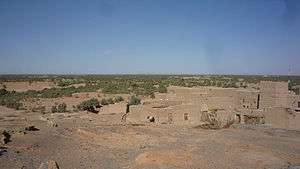Tafilalt
Tafilalt تافيلالت | |
|---|---|
Region | |
 Panorama of the oasis of Tafilalet, seen from the ksar of Tingheras (Rissani). | |
| Country | |
| Region | Meknès-Tafilalet |
| Time zone | UTC+0 (WET) |
| • Summer (DST) | UTC+1 (WEST) |
Tafilalt or Tafilet (Arabic: تافيلالت) is a region and the most important oasis of the Moroccan Sahara; it is also considered one of the largest oases in the world, the oasis is entirely located along the Ziz River. The oasis is ten days' journey south of Fez, across the Atlas Mountains. It is celebrated for its large and luscious dates, to the successful cultivation of which, soon after the arrival of an ancestor (Al Hassan Addakhil) of the reigning dynasty of Morocco (the Alaouite Dynasty) around 1250, this dynasty owes its rise to power.
Since 1648 it has been the custom of Moroccan sultans to despatch superfluous sons and daughters to Tafilalt. The inhabitants occupy fortified villages (Ksar). In Ifli, the central portion, formerly existed the town of Sijilmasa, founded by Miknasa Berbers in 757. It was on the direct caravan route from the Niger to Tangier, and attained a considerable degree of prosperity. It was destroyed, but its ruins still extend five miles along the river bank.
The name Tafilalt is a Berber name meaning "the Country of the Hilali", as its inhabitants are called, because they were descended from the Arabian tribe of Banu Hilal, who settled here [citation needed].
Medieval traveler Ibn Batuta visited Sijilmasa (near Tafilalt) in the fourteenth century on his journey from Fez to "the country of the blacks".
The first European to visit Tafilalt in the modern era was René Caillié (1828), the next Gerhard Rohlfs (1864). A later visit to the oasis by WB Harris is described in his book Tafilet (London, 1895).
""The oasis is ten days' (historic, by animal) or one day's (modern, by motor vehicle) journey south of Fez, across the Atlas.""
It is the birthplace of Baba Sali.
References
- This article incorporates text from a publication now in the public domain: Chisholm, Hugh, ed. (1911). Encyclopædia Britannica (11th ed.). Cambridge University Press.
{{cite encyclopedia}}: Missing or empty|title=(help)
Further reading
- Harris, Walter B. (1895), Tafilet; the narrative of a journey of exploration in the Atlas Mountains and the oases of the north-west Sahara, Edinburgh: W. Blackwood and Sons.